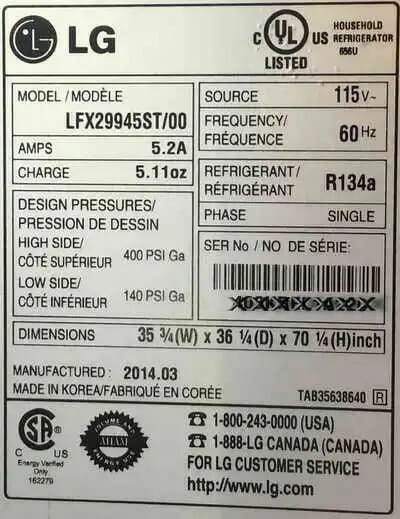Can a Refrigerator be on a 15-Amp Circuit

Whether a refrigerator can be placed on a 15-amp circuit depends on the refrigerator’s power consumption and whether it’s a shared or dedicated circuit.
In general, you can have a refrigerator on a 15-amp circuit, but only if the refrigerator consumes no more power than the circuit can handle. A refrigerator normally consumes 300-800 watts, which is fine. Most refrigerators can easily be placed on it, but if it’s a shared circuit, you must consider the total power consumption across all the used appliances. A 20-amp dedicated circuit may be necessary only if it’s a large refrigerator or has special features.
I will go into more detail below.
Power Consumption of Refrigerators
A typical home refrigerator consumes between 300 and 800 watts of electrical power.
In a 120-volt system, the current draw is between 2.5 and 7 amps, respectively. More energy-efficient models require less power, and a mini-fridge might use up to 120 watts. The actual wattage is usually stated on a plate on the back of the unit. It depends on its size or capacity, type of refrigerator, ambient temperature, and how old it is.

However, the average, or “running wattage,” is lower than the stated wattage because a refrigerator cycles on and off throughout the day.
Some refrigerators consume more power than a typical one. If you have such a refrigerator, you should check its power requirement to be sure it can run on a 15-amp circuit.
The Capacity of a 15-Amp Circuit
A standard 15-amp circuit in a 120-volt system typically handles up to around 1,440 watts or a maximum of 1,800 watts.
This was worked out by calculating: 15 x 120 x 0.8. A refrigerator’s typical power consumption (300-800 watts) is well within this limit, so it can be used safely if it’s the only appliance on the circuit.
However, if it’s a shared circuit, you must also account for the power consumption of other appliances on the same circuit. The total power consumption must not exceed this limit.
Refrigerators on Dedicated Circuits
If you have a large-capacity refrigerator, even if you can run it on a 15-amp circuit, it may be better to run it on a dedicated 20-amp circuit instead.
If your refrigerator has one or more of the following features, it may require a higher-capacity circuit:
- auto defrost
- adjustable thermostat
- electronic insulation
- ice-maker
Also, as you may expect, if the refrigerator is large, it probably consumes much power. A higher-capacity circuit requires thicker gauge wire and a higher-rated circuit breaker.
For example, a 20-amp circuit typically has a 10-gauge wire and a 20-amp circuit breaker.
To know the exact power requirement of your refrigerator, look at the power consumption label on its back or in its manual.
A large refrigerator may require about 8 to 12 amps (~900-1500 watts). A dedicated 15- or 20-amp circuit is better (a 20-amp one with 12 amps or above 1,400 watts). This means not sharing that circuit with any other appliance running simultaneously.
FAQs
What is the typical running wattage of a refrigerator?
The running wattage of a refrigerator is usually around a third of the stated or maximum wattage. So, to work out the running wattage, divide the stated wattage by 3. For example, a 400-watt refrigerator will have a running wattage of approximately 134 watts.
Can I put a 20-amp circuit breaker on a 15-amp circuit for my refrigerator?
No, it would be best if you never did that. If you do and the current exceeds the circuit’s 15-amp limit, the breaker will not trip unless it reaches close to 20 amps. But the thinner wire will not be able to handle the high current, which would cause a fire risk. A 20-amp circuit will require a thicker gauge wire as well.
Can I plug my refrigerator into a regular outlet?

Yes, of course, you can. However, ensure you have the right type of outlet for the plug and voltage. Also, ensure that the outlet is properly grounded and that the refrigerator’s cord is long enough to reach the outlet.
